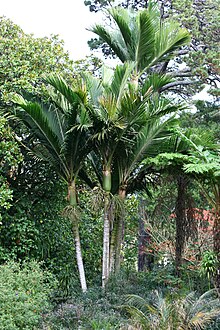Rhopalostylis: Difference between revisions
Content deleted Content added
rmv incorrect nl interwiki |
change pics |
||
| Line 5: | Line 5: | ||
| image = Nikau_Palm.jpg |
| image = Nikau_Palm.jpg |
||
| image_width = 240px |
| image_width = 240px |
||
| image_caption = |
| image_caption = Flowers of ''R. sapida'', Paparoa National Park, New Zealand |
||
| regnum = [[Plant]]ae |
| regnum = [[Plant]]ae |
||
| divisio = [[Flowering plant|Magnoliophyta]] |
| divisio = [[Flowering plant|Magnoliophyta]] |
||
| Line 17: | Line 17: | ||
}} |
}} |
||
[[Image: |
[[Image:KermadecNikau.jpg|thumb|left|220px|''R. bauerii'']]'''''Rhopalostylis''''' is a [[genus]] of two or three species of [[arecaceae|palms]] native to the [[Oceania|South Pacific]]. Both are smooth-trunked, with regular ringed scars from fallen leaves. The leaves are 3-5 metres in length, and the leaf bases encircle the trunk. |
||
;Species |
;Species |
||
Revision as of 06:52, 10 July 2007
- For the genus Rhopalostylis Klotzsch ex. Baill., of the family Euphorbiaceae, see its current synonym Dalechampia.
| Rhopalostylis | |
|---|---|

| |
| Flowers of R. sapida, Paparoa National Park, New Zealand | |
| Scientific classification | |
| Kingdom: | |
| Division: | |
| Class: | |
| Order: | |
| Family: | |
| Genus: | Rhopalostylis |
| Species | |
|
See text | |

Rhopalostylis is a genus of two or three species of palms native to the South Pacific. Both are smooth-trunked, with regular ringed scars from fallen leaves. The leaves are 3-5 metres in length, and the leaf bases encircle the trunk.
- Species
- Rhopalostylis baueri (syn. R. cheesemanii)
- Rhopalostylis sapida
Rhopalostylis has the southernmost range of any palm genus. R. sapida, known as the Nikau Palm, is New Zealand's only native palm species, and is found in lowland forests on the North Island, in coastal areas of the South Island as far south as Banks Peninsula, and on the Chatham Islands. R. baueri occurs on Norfolk Island and the Kermadec Islands northeast of New Zealand; the Kermadec Islands population is separated as R. cheesemanii by some botanists.
